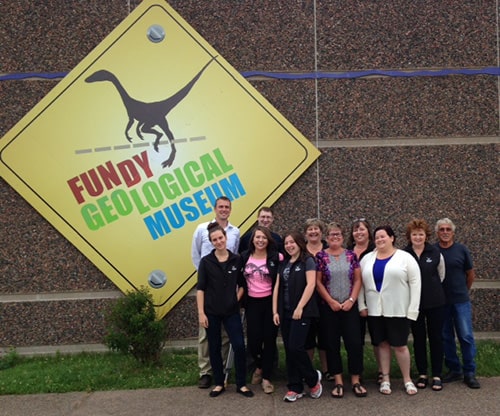
 New dinosaurs have been found at the Bay of Fundy fossil site.
New dinosaurs have been found at the Bay of Fundy fossil site.
The Fundy Geological Museum, in Parrsboro, Nova Scotia has put the finishing touches on a new display of dinosaur bones that date back 200 million years, and the public is invited to tour the grounds where the fossils were first discovered at Wasson Bluff in Cumberland County.
“The new lizard-like reptile skulls and teeth found this year are very important for providing a window into an ancient earth that was recovering from a global mass extinction,” says Tim Fedak, director and curator of the museum. “It is exciting to think what else we may find as work continues this summer.”
Just last month, the museum’s research team found four lizard-like reptile skulls with jaws and teeth intact, along with a theropod dinosaur skull bone and a tooth from a tiny mammal-like reptile.
Stretching over a kilometre along the north shore of Minas Basin in the Bay of Fundy, the cliffs at Wasson Bluff are a treasure trove of Canada’s oldest known dinosaur fossils. Over time the massive tidal forces in the Bay of Fundy have worn away parts of the cliffs to reveal sections of rock from 200 million years ago, a time just at the start of the Jurassic period where dinosaurs became the dominant animal group on the planet.
The Fundy Geological museum is offering guided tours of the Wasson Bluff site, to give the curious and dino-fascinated (admission is free for kids aged 12 and under) a first-hand look at the grounds where some of Canada’s oldest dinosaurs once roamed. Researchers with the museum including Fedak will be on hand to give an account of the region and its fossil finds, with the museum calling it, “a great Bay of Fundy experience.”
Lasting a good 135 million years, the reign of the dinosaurs is known to have come to an abrupt end 66 million years ago with the mass extinction of three-quarters of Earth’s plant and animal species and the complete decimation of all dinosaur species save for the avian versions, ancestors to modern day birds. Scientists are now in general agreement that the mass extinction -dubbed the Cretaceous-Tertiary (K-T) extinction event- was caused by an asteroid impact, likely that which created the Chicxulub crater in the Gulf of Mexico and said to have landed with the force of over a billion atomic bombs.
Yet, how exactly the extinction transpired has been a topic of debate for quite some time, with experts suggesting that the asteroid impact kicked up enough dust to block out the sun over the whole planet, causing plant life to die and the rest of the food chain to quickly follow, while another theory has it that enormous quantities of sulphates from the impact contaminated the atmosphere around the globe.
But a new study in the journal Scientific Reports claims to have found an alternative and moreconvincing explanation: soot.
Researchers from Tohoku University in Japan and the Japan Meteorological Agency compared sedimentary organic molecules from near the Chicxulub site in Haiti with some from further afield in Spain and determined that the impact layers from both sites had the same composition of combusted organic molecules – in other words, the same kind of soot, which were likely produced by the same cataclysmic impact. Soot acts as a light-absorbing aerosol which the study’s authors suggest caused dramatically colder climates around the planet once the asteroid hit.
Leave a Reply
You must be logged in to post a comment.




 Share
Share Tweet
Tweet Share
Share




Comment